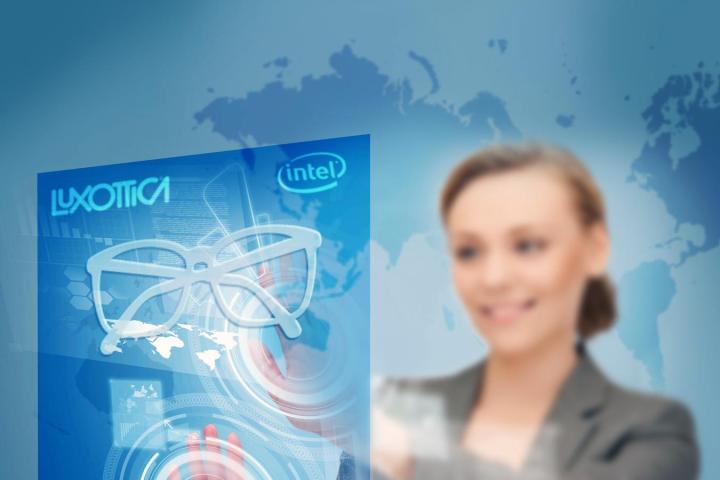
Because Intel makes chips, not actual products we go out and buy, it’s furiously building reference hardware based on its tiny wearable-specific processors to inspire others. It’s also buying well-respected firms already established in the business, mentoring those which are still growing, and partnering up with other massive companies not wanting to miss out on a trend said to be worth $5.8 billion by 2018.
Intel’s not only targeting face-wear, it’s attacking the entire wearable industry.
Intel’s latest coup, and an incredibly important one, is a multiyear alliance with Luxxotica. Not familiar with the name? The Italian corporation essentially owns the eyewear industry, and is responsible for names such as Oakley, Ray-Ban, and Arnette, plus it has the license to produce spectacles for D&G, Chanel, Prada, and many more major designer brands. Oh, and it owns Sunglass Hut. Intel and Luxxotica are joining forces to make smart eyewear, and will release their first device together in 2015.
These two industry titans — one an expert in fashion and retail, the other in tech and processing power — are teaming up to crack the smart glass conundrum. The competition should be very afraid. But Intel isn’t taking any chances here; it’s not only targeting face-wear, it’s attacking the entire wearable industry.
So many fingers in so many pies
Sitting comfortably? Good. Here’s how deeply Intel’s getting into wearables. Earlier this year, it teamed up with Fossil to “accelerate wearable technology innovation worldwide,” with a particular focus on fashion and lifestyle. It already owns Basis Science, makers of a well-respected fitness smartwatch, and snapped up ST-Ericsson’s geo-location business to produce low-power, small-size, wearable-friendly GPS chips.
It has partnered with 50 Cent to make the SMS Audio BioSport headphones, AIQ in Taiwan to produce high-tech textiles, and fashion label Open Ceremony to build the MICA smart bracelet. Its chip powers the outrageous, emotion-reading Synapse Dress. It’s working with The Michael J. Fox Foundation on a wearable to treat Parkinson’s disease, developing cross-platform augmented reality apps, and on the rumor front, it may get its own processor inside Google Glass 2, and also TAG Heuer’s first smartwatch.
Through Intel Capital, it has invested in Thalmic Labs’ Myo Armband project, Bluetooth smartwatch experts Appscomm, eye-tracking specialists Eyefluence, plus several fitness and medical wearable firms. Recently, the winners of Intel’s Make It Wearable competition were announced, which was as much about mentoring the firms and making them part of the Intel family, as it was about choosing a winner.

Many of these projects use Intel’s versatile Edison chip, specifically designed for larger wearable devices, which supports various operating systems, comes with Bluetooth and Wi-Fi connectivity, and its own app store. The minuscule Quark processor will drive smaller wearable devices. Some of Intel’s reference hardware is more basic, such as its SMS Audio headphones, but remain “smart” enough to be relevant.
Intel. Is. Everywhere. Intel’s wearable PR manager, Ellen Healy, told TomsHardware.com, “We’re focused on creating reference designs and an end-to-end solution — software to security to hardware — that really empowers partners to develop cutting-edge products that are going to make wearable technology mainstream and viable.” If that doesn’t perfectly sum up Intel’s supercharged mission, we don’t know what does.
There are just a couple of problems with Intel’s masterplan
Despite all this, there are two problems with Intel’s plan. Manufacturers are still trying to work out what to do with wearables, and the public still isn’t sure it actually wants them at all. Analysts are convinced wearables are going to be huge over the coming years, but regular people still need some persuasion. Worryingly for Intel, the average smartphone buyer is only vaguely aware of wearable tech at the moment, if at all.
It’s absolutely imperative that the magical product which convinces normal people wearables are cool has an Intel processor inside.
We’re getting smartwatches, fitness bands, and a sprinkling of smart clothes; but innovation is lacking. Everyone is jostling to come up with a product the world wants to wear, instead of just geeks. Smart eyewear could prove even more challenging, after Glass has become almost inextricably linked with controversy, ranging from privacy to piracy.
Ultimately for Intel, it’s absolutely imperative that the magical product which convinces normal people wearables are cool has an Intel processor inside. If not, all this effort will have gone to waste, and once again, it’ll be scratching about for scraps in a rapidly growing, lucrative space. This won’t be news to Intel, and helps explain its seemingly scattershot approach, and an interest in everything from smart eyewear to smart underwear.
It may not be pretty, or particularly focused, but it could work. Intel has the money to do it, the R&D talent to push development forward, and perhaps most importantly, an overwhelming desire to dominate. Avoiding another embarrassing mobile-style misstep probably spurs it on nicely. By inspiring manufacturers, backing almost anyone with an interesting idea, and providing the tools to make the products reality, Intel’s doing its damnedest to ensure it’s as essential to wearable tech, as the stitching is to our clothes right now.
Editors' Recommendations
- This isn’t an AirPod — it’s a wearable unlike any I’ve seen before
- Is it time to shut your mouth? This smart wearable will let you know
- Stretchable, self-healing, recyclable device could be the future of wearables
- Your wearables can soon help contact trace coronavirus outbreaks
- Fitbit wants to find out if wearables can detect coronavirus



